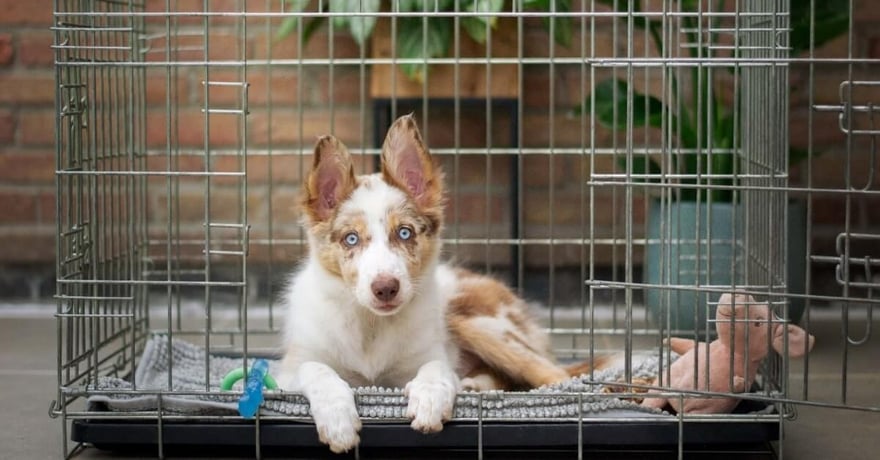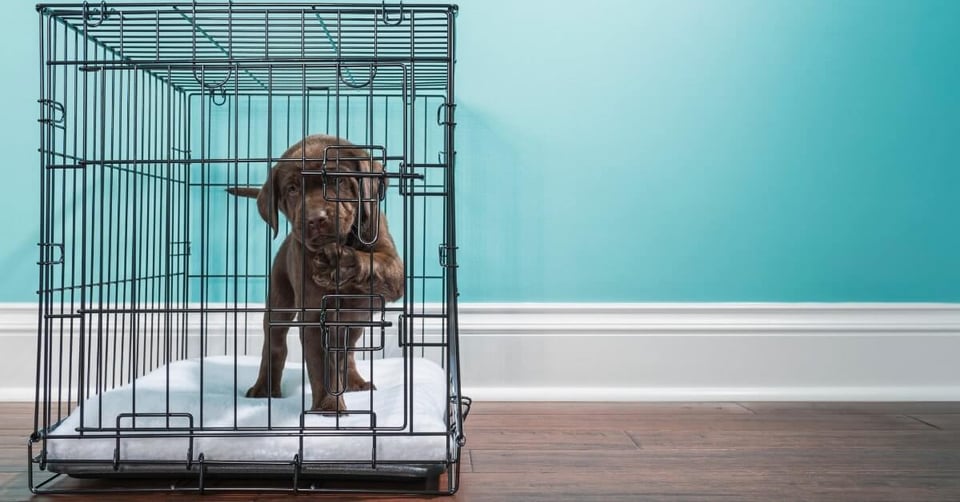How to Crate Train Your Puppy: 3 Easy Steps

Crate training puppies can feel a little uncomfortable to those who aren’t familiar with its benefits, but in reality, it’s a great training technique for all sorts of reasons. Crate training is not about about locking your pooch away in a cage (no way) but rather creating a safe space for them to treat as their own.
We’ve put together this article to explain the reasons that puppy crate training is so useful, along with some information on the right and wrong ways to do it, so you can crate your dog with confidence.
Why Crate Train a Puppy?
The idea of putting a sprightly, excitable young dog in a crate or cage may seem a little unnatural, but it can come with huge benefits. For one, it’s a great way to keep your dog under control until it fully learns the rules of the house.
In their first weeks and months, puppies are still learning about their world, as they’re highly curious, so in their early years, they may have a tendency to take toilet breaks in the house and chew on things that aren’t meant to be chewed on. Puppies (and dogs) can have bursts of very high-energy, so crate training them early is a great way to keep them calm and preventing them from getting into too much trouble while they’re young.
Crate training is also useful because it prepares them for situations where they may not be able to move as freely as they’re used to, such as during long-distance travels. Along with this, setting them up with a good crate will give them a space to end the day in that’s essentially like their own room.
Picking Your Crate
When it comes to buying your puppy training crate, there’s a simple rule of thumb that you should follow. Bigger is not always better. The crate should essentially be large enough for your dog to stand freely and turn around 360 degrees — any more than that, and the training will be less effective and, with too much room, there is a higher likelihood they may also use their crate as a bathroom.
The crates themselves will generally be made from either plastic or collapsible metal and will all generally do the same thing, but you should still browse to find the one that suits your home aesthetic, and more importantly, your puppy.
How Long Might It Take to Crate Train a Puppy?
When it comes to the time it takes to crate train your puppy, it can take days, weeks, or even months depending on their personality, age, and past experiences. Remember, older dogs will take a little longer. The important thing is to be patient and let the process run its course naturally rather than getting frustrated with your puppy, as that will just push things back even further.
Puppy Crate Training
Step 1: Introduction
Make sure that you position your crate in an area of the house where you and your family spend a lot of time to ensure that it doesn’t feel like a place of isolation. Next, prep the crate by opening and fastening the door wide, and line the floor with some soft warm blankets. Once you’ve completed these preparatory steps, it’s time to introduce your puppy to the crate.
Softly bring your puppy over to the crate while using a friendly tone of voice. Then, encourage them to enter the crate. If this is difficult, try urging them in by placing a little bit of food, a treat, or a toy in the crate. If they refuse at first, don’t worry — sometimes, these things take time. Once the dog is happy to walk into the cage calmly, reward them with another treat, and then it’s time to move onto the next step.
Step 2: Mealtimes
Now that your puppy is walking into the crate with confidence, you should condition them to eat their primary meals in there. The way to do so is simply by placing their feeding bowl into the crate and letting them go to it. If they’re reluctant to go all the way in at first, place it closer to the door and incrementally push it further back with every feeding.
Once they’re happy to eat in the crate, try shutting the door during the meal and opening at as soon as they finish. As you do this, try leaving the door shut for longer with each feeding until they’re comfortable with being in there for around ten minutes after a meal. If they react badly to the longer periods of being shut in, reduce and then increase the time according to their reactions.
Step 3: Longer periods
Once they’ve gotten used to eating in the crate, you need to teach them to stay in there for a longer period of time without a full meal. Create a command like “go to your crate” (or something more creative!) and encourage them into the crate, rewarding them with a treat. Then, close the door, sit in the room quietly for a moment, and leave for around ten minutes. Repeat this process, leaving for a longer and longer amount of time until the dog is comfortable in the crate without you there.
Once you’ve completed this step, it’s just the same basic principles when it comes to leaving the house and putting them to bed. Make sure that the crate is comfortable and has things in it to keep your puppy occupied, such as safe toys. While they’re still very young, puppies shouldn’t be left alone for longer than an hour for each month they’ve been alive, so don’t go missing for too long. Sensitively handling separation anxiety in a puppy can be a tricky business so being patient, kind and slow will have long-term benefits.

Crate Training Tips:
- Never treat the crate as a punishment
- Make it comfortable
- Reward their compliance
- Make time for walks and play
- Take off any tags, collars, or clothes, to maximize comfort
- Be wary of time away
- Patience, patience, PATIENCE!
Now that you know how to properly crate train a puppy, you can search for your dog and the crate to match!
At PHI Direct, we believe that pet owners should strongly consider pet insurance, so take the time to research the right policy provider. Get a low-cost + high-value pet insurance quote from PHI Direct today.
Posted on June 20, 2022 | Categories: Puppy Training
Share


